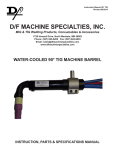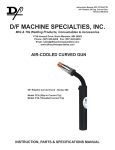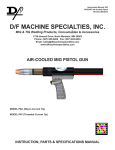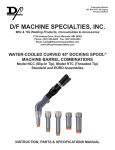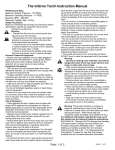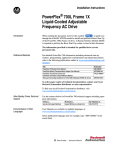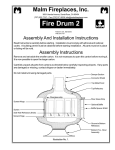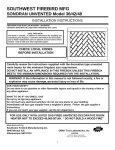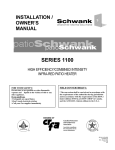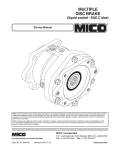Download Instruction Manual KMF TIG Barrel
Transcript
Instruction Manual KMF Kel-Melt Furnace W/C TIG Barrel Revised 06/2014 D/F MACHINE SPECIALTIES, INC. MIG & TIG Welding Products, Consumables & Accessories 1750 Howard Drive, North Mankato, MN 56003 Phone: (507) 625-6200 Fax: (507) 625-6203 www.dfmachinespecialties.com WATER-COOLED TIG BARREL for Kel-Melt Furnace INSTRUCTIONS, PARTS & SPECIFICATIONS MANUAL D/F MACHINE SPECIALTIES is a world leader in the design, development, and manufacture of “MIG” (GMAW) & “TIG” (GTAW) welding products, consumables and accessories. D/F offers several types of manual Air or Water-Cooled “MIG” welding tools, and with the increased use of automated and robotic welding systems, a demand has been created for welding tools of the highest quality, durability and interchangeability. For over forty years, D/F welding products have been used extensively on “MIG” and “TIG” welding applications. This experience, coupled with patented design features, unavailable on any other competitive equipment, has made D/F welding tools the most advanced “MIG” and “TIG” welding guns and barrels for semi-automatic, automatic or robotic welding applications. This Catalog is a guide to helping you select the proper tool for a given semi-automatic, automatic or robotic welding application. The following is only a partial listing of available semi-automatic, automatic and robotic guns. For further information on special “MIG” and “TIG” requirements, please consult the factory. Customer satisfaction and customer benefits are the center points of all strategic contents The spirit of the D/F Machine Specialties personnel is to listen to and to integrate the customer throughout the process, to develop and design marketable products, to present prototypes, to carry out pilot tests and to prepare for and be open to new technology and tasks. We attract and carefully select talented individuals who share our values. Together we will nurture and sustain a work environment with two-way communication, training, mentoring, and rewarding career opportunities. Innovation and quality Innovation and quality come from being receptive and willing to learn from others. We encourage our people to be creative and take risks in the pursuit of excellence. Innovative practices are deeply rooted in every one of our employees, a philosophy that leads to continuous product development and industry firsts. Progress By remaining confident, focused, and persistent in challenging times, we will discover opportunity. Commitment to quality and the pursuit on innovation ensure that D/F Machine Specialties will remain an industry leader for years to come. Commitment to excellence At D/F Machine Specialties we commit to design, build and deliver premium products and superior customer support to quality driven welding professionals. Customers still to this day choose D/F over competitors because of our responsiveness and flexibility. Customers will continue to choose D/F tomorrow for our superior hand-made products and service. To ensure this, we need creative and competent personnel in all business divisions, an intensive exchange of thoughts and ideas with all users, participation in working and study groups within the field of welding technology and intensive cooperation with institutes and universities. Teamwork Striving for excellence is a commitment that is an integral component of the D/F Culture. Our team of skilled and dedicated employees takes pride in the excellence products they produce. Each of us willingly accepts personal responsibility for meeting our commitments and we hold each other to a high standard of accountability. Responsibility We will continually strive to be environmentally responsible and to support the health and safety of our employees, customers, and neighbors. We continue to support the communities in which we operate and the industries in which we participate. Thank You for Choosing D/F Machine Specialties TABLE OF CONTENTS Introduction, KMF TIG Barrel - Parts..............................................................................5 Barrel Dimensions..........................................................................................................6 Troubleshooting.........................................................................................................7-10 SAFETY MEASURES - **PLEASE READ!** Welding is not particularly hazardous when certain safety practices are followed. Anyone using this equipment should be thoroughly trained in safe welding practices. Failure to observe safe practices may cause serious injury. Handling welding torches presents no danger if the appropriate safety regulations are strictly adhered to. For example: • Starting-up procedures must be reserved for those fully conversant with processes relating to arc welding equipment. • Arc welding can prove damaging to eyes, skin, and hearing! It is therefore imperative that the Accident Prevention Regulations UVV 26.0 and VGB 15 are fully observed and that all protective clothing, eye and ear protectors specified are worn. • The load data given are maximum limit figures. Overloading will inevitably damage the torch! • Before changing wear parts, disconnect for the power supply. • The operating instructions for the individual welding components - e.g. power source, wire feed and cooling unit must be followed. • Never pull the cable assembly across sharp edges or set down close to weld spatter or on a hot workpiece. • Those not involved in the welding process should be protected by curtains or partitions from radiation and the danger of being dazzled. • When handling gas cylinders, consult the instructions issued by the manufacturers and the suppliers of the pressurized gas. • Workpieces which have been degreased using chlorinated solvents must be sprayed down with clean water before welding starts to avoid the risk of phosgene forming. For the same reason, no degreasing baths containing chlorine must be placed close to the welding point. • All vapors given off by metals can cause harm and a special warning is attached to lead, cadmium, copper, zinc, and beryllium. If necessary, take appropriate precautions (by providing adequate ventilation or an extraction system) to ensure that the legal maximum levels of toxic concentrations are not exceeded. For more information, refer to the following standards in their latest revisions and comply as applicable. • ANSI Standard Z49.1, SAFETY IN WELDING AND CUTTING obtainable from the American Welding Society, 2501 N.W. 7th St., Miami, FL 33125. • ANSI Standard Z41.1, STANDARD FOR MEN’S SAFETY - TOE FOOTWEAR obtainable from the American National Standards Institute, 1430 Broadway, New York, NY 10018. • ANSI Standard Z49.2, FIRE PREVENTION IN THE USE OF CUTTING AND WELDING PROCESSES obtainable from the American National Standards Institute, 1430 Broadway, New York, NY 10018. • OSHA, SAFETY AND HEALTH STANDARDS, 29CRF 1910, obtainable from the U.S. Government Printing Office, Washington, D.C. 20402. • AWS Standard A6.0, WELDING AND CUTTING CONTAINERS WHICH HAVE HELD COMBUSTABLES obtainable from the American Welding Society, 2501 N.W. 7th St., Miami, FL 33125. • NFPA Standard 70-1978, NATIONAL ELECTRICAL CODE obtainable from the National Fire Protection Association, 470 Atlantic Avenue, Boston, MA 02210. • ANSI Standard Z88.2, “Practice for Respiratory Protection” obtainable from the American National Standards Institute, 1430 Broadway, New York, NY 10018. • ANSI Standard Z87.1, SAFE PRACTICES FOR OCCUPATION AND EDUCATIONAL EYE AND FACE PROTECTION obtainable from the American National Standards Institute, 1430 Broadway, New York, NY, 10018. • NIOSH, SAFETY AND HEALTH IN ARC WELDING AND GAS WELDING AND CUTTING obtainable from the Superintendent of Documents, U.S. Printing Office, Washington, D.C. 20402. • American Welding Society Standard AWSF4.1 “Recommended Safe Practices for the Preparation for Welding and Cutting of Containers and Piping That Have Held Hazardous Substances”, obtainable from the American Welding Society, 2501 N.W. 7th St., Miami, FL 33125. IMPORTANT The D/F torch is famous for the fact that if it is chilled properly, the welder can grab the front of the torch with their bare hand and it will be cold to the touch seconds after welding. With the proper chiller, this can be done even after a 4 hour arc time. Make certain the cooling water supply is at least the minimum flow rate of 3 quarts per minute (for each inner body), at 40 psi (80 psi maximum) with a 5 gallon reservoir and 15,000 BTU/hr cooling capacity. Gun ratings are affected by shielding gas used, arc time, cooling time and inlet water temperature. Water outlet temperature should not exceed 27°C (80°F). The torch’s water out & power cable is not cooled until the coolant has gone through the torch and out the water out & power cable. If water is not flowing through the D/F torch for at least 1 minute prior to striking an arc, when you apply the power and water hits the “hot” water/out & power cable, you will generate steam. Steam can damage the torches internals in seconds causing a leak. It can also blow out the torches water/out & power cable. A flow switch can be installed after the return line ensuring that coolant is present at the return line prior to striking an arc. When High-Deposition GMAW or extended periods of arc time are used, it is recommended that a liquid chiller be considered with a larger reservoir and a minimum of 30,000 BTU/hr cooling capacity. Precise temperature control maintains the cooling at a constant 13°C (55°F) temperature, thus prolonging the life of the welding equipment and more specifically extending the service life of the gas nozzle and current tip. A refrigerated liquid chiller for GMAW may be obtained from: For single torch chillers: Dynaflux - 800-334-4420 - www.dynaflux.com For multiple torch cooling systems: Koolant Koolers - 800-968-5665 - www.koolantkoolers.com INTRODUCTION For further information or help with D/F Machine Specialties products, please visit our web site at www.dfmachinespecialties.com, or consult the factory at 1-507-625-6200. WATER COOLED TIG BARREL - PARTS REF. CODE NO. 1 2 3 1 4 5 30407 19272 19273 19274 18157 18158 18159 18160 15895 15896 15897 15898 30413 46320-4 DESCRIPTION Inner Body Collet .040” Collet 1/16” Collet 3/32” Collet 1/8” Collet 5/32” Collet 3/16” Collet 1/4” Gas Nozzle 1/4” Gas Nozzle 3/8” Gas Nozzle 1/2” Gas Nozzle 5/8” Heat Shield Disc Water Out/Power Cable 4 Ft. NOTE: Add Footage to Code Number for Length Desired Example: Require 6 Ft.Water Out/Power Cable - 46320-6 4 2 3 5 KMF TIG BARREL - DIMENSIONS 6” 1” 2” 1.125” 2.030” .930” 6 TROUBLESHOOTING: POROSITY (SUMMARY) NOTE: Most POROSITY is caused by gas problems, followed by base metal contamination. Causes of Porosity Possible Solutions BASE METAL CONTAMINATION Impurities on base metal a. Remove contamination; clean surfaces b. Use of specific wire/gas mix for specific types of impurities FILLER METAL CONTAMINATION Impurities on filler metal (wire) a. Replace wire b. Install wire-cleaning system c. Prevent industrial dust/dirt/grit from contaminating wire during storage or use d. Prevent build-up of aluminum oxide on exposed aluminum wire surface by using up quickly e. Remove wire from wire drive unit and store in a sealed plastic bag when not in use for long periods ATMOSPHERIC CONTAMINATION Drafts, wind, fans, etc. a. Protect weld from drafts (curtains/screens) b. Use tapered or bottleneck gas nozzles when drafts cannot be avoided GAS MIXING APPARATUS 1. Too high a gas flow, causing turbulence, and/or sucking air at hose connections; creating the venturi effect at end of gas nozzle 2. Too low a gas flow, causing insufficient gas coverage 3. Damaged or kinked gas lines 4. Too high an oxygen content 5. Leaks in gas distribution system 6. Other impurities in gas - moisture, etc. 7. Inconsistent gas flow (cfh) at the torch connection 1a. Reduce gas flow 1b. Tighten all hose connection points 2. Increase gas flow 3. Repair or replace 4. Adjust mixer 5. Repair leaks 6. Overhaul system; fit filters and/or dryers 7. Regulate pressure into flow meter for consistent cfh delivery of gas GAS TURBULENCE 1. Excessive spatter build-up in gas nozzle and on current tip 2. Nozzle damage, causing uneven gas coverage 3. Torch gas ports clogged or deformed 4. Super-heated nozzle, causing shielding gas to expand rapidly and create return effect at end of nozzle 5.Gas diffuser/nozzle insulator missing 6. Too high a gas flow causing the venturi effect 1. Clean nozzle and tip regularly; spray with anti-spatter fluid 2. Replace nozzle 3. Clean or replace 4. Check duty cycle rating of torch 5. Replace 6. Reduce gas flow WELDING PARAMETERS, ETC. 1. Too long a wire stick-out; gas nozzle too far from weld puddle 2. Bad torch position - too sharp a torch incline causing the venturi effect at the end of the nozzle leading to atmospheric contamination 3. Excessively wide weld pool for nozzle I.D. 1. Use longer nozzle or adjust stick-out (3/8” minimum or 15 times wire diameter) 2. Correct torch angle 3. Width of the weld pool should be 1.3 times the nozzle I.D.; use suitable wider gas nozzle 4. Reduce voltage 5. Reduce speed 4. Arc voltage too high 5. Too high a travel speed 7 TROUBLESHOOTING: SPATTER Possible Solutions Problems/Causes SPATTER Too fast or too slow wire feed for the arc voltage Set the wire feed rate and voltage in accordance with good welding practices as recommended by a qualified welding engineer. Too long an arc Adjust the wire feed and voltage so that the arc is in accordance with good welding practice for the joint to be welded. The distance from the current tip to the workpiece should be 15 times the welding wire diameter. If the arc is too long there will be spatter, usually in the direction of the weld. Damaged current tip If the current tip becomes worn the welding wire will not be in constant contact with the tip and the arc will become unstable. A current tip contaminated with spatter will cause uneven wire feed resulting in further spatter. Inclination of welding gun too great The angle of the gas nozzle relative to the workpiece should be between 45 and 90 degrees. If the angle is too small, the wire runs parallel to the weld pool, resulting in spatter in the direction of the welding. Faulty power source Have the power source checked for faulty conditions such as broken wires and faulty contacts. Incorrect start A great deal of spatter occurs if the stick-out is too great and if the welding gun is held too far from the workpiece when striking the arc. Try to start with as short a stick-out as possible and with the welding gun as close to the starting point as possible. If a large ball end is formed on the end of the welding wire, remove it by cutting the wire with sharp wire cutters. It is helpful if the wire is cut to a point. Always remove the ball end before striking an aluminum arc. Check the welding ground connection. Incorrect pulse parameters Check the user manual for your power supply or consult a qualified welding engineer. Uneven wire feed Uneven wire feed gives rise to heavy spatter. Find the cause of the disturbance and correct the condition before proceeding. Impurities on the base metal Paint, mill scale, rust and other contamination on the base metal form an insulating layer causing an unstable arc that results in heavy spatter. Clean the surfaces to be welded. Poor ground contact Inspect ground cable for loose connections, fraying and cuts. Correct any problem areas found and attach the ground cable directly to the workpiece after having cleaned the contact surface first. POOR GROUND CONTACT IS THE MOST COMMON CAUSE OF UNSTABLE MIG WELDING CONDITIONS. Too long stick-out (short-arc welding) The stick-out should be 15 times the diameter of the wire electrode being used. With increasing stick-out, the current is reduced and the arc voltage rises, giving a longer unstable arc and increased spatter. Incorrect polarity Check for correct polarity. Follow the electrode manufacturer’s recommendations. 8 TROUBLESHOOTING: GENERAL GUIDE Problems/Causes ERRATIC WIRE FEED Slipping feed rolls Possible Solutions Check that the feed roll size is correct for the wire size being used. Increase the drive roll pressure until the wire feed is even. Do not apply excessive pressure as this can damage the wire surface, causing copper coating to loosen from steel wires or metal shavings to be formed from soft wires like aluminum. These metal fragments or shavings can be drawn into the wire feed conduit and will rapidly clog the liner. When welding with flux-cored wires, excessive drive roll pressure may open the wire seam and allow flux or metal powders to escape. Clogged or worn gun liner a. Dust, particles of copper, drawing lubricants, metal or flux and other forms of contamination can all clog the liner so that the wire feed is slowed or impeded. A liner that has been in use for an extended period of time becomes worn and filled with dirt and must be replaced. b. When changing the welding wire, remove the tip from the front end of the gun and blow out the body liner with clean, dry compressed air from the back of the gun. Repeat with the casing and liner assembly. Note: Wear safety goggles when using compressed air to clean the liners. Make sure proper safety procedures are followed in order to avoid possible serious eye injury. Liners too long or too short Check the lengths of the liners and trim or replace if too long or too short. The efficient feeding of the welding wire is dependent on the liners fitting correctly. Spatter on the wire Coil brake incorrectly adjusted UNSTABLE ARC Incorrect setting of voltage and/or current Problems in wire feeding: worn current tip Impurities on the base metal Poor contact between ground cable and workpiece or loose power connection Stick-out too long An unprotected coil of wire quickly collects dust and other airborne contamination. If grinding is being performed in the vicinity, particles can become attached to the wire, severely interfering with the wire feed. Replace with clean wire and keep it protected with a cover. Make sure spare wire rolls are stored in a clean, dry place. Set the brake so that the coil immediately stops rotating as soon as welding is interrupted. If the brake is applied too hard it will cause the feed rolls to slip, resulting in uneven wire feed. If it is too loose, overrun of the wire will occur, causing wire tangles, inconsistent tension on the feed mechanism and irregular arc characteristics. Set the wire feed in relation to the arc voltage in such a way that the arc is stable and burns evenly. In spray arc welding, set the wire feed so that there are no short circuits and the filler metal is transferred in a spray across the arc. Find the cause of the interference and correct it. (See ERRATIC WIRE FEED above) When the internal diameter of the current tip becomes worn from the passage of wire through it, the wire may no longer stay in continuous electrical contact with the tip. This results in an unstable arc and an increase in spatter. Paint, mill scale, silicon scale, rust or flux deposits from previous weld runs may form an insulating layer causing an unstable arc. Clean the surfaces to be welded. Securely attach the ground cable as close to the point of welding as possible on the workpiece. Clean the surfaces thoroughly to ensure good contact. Check to insure the welding power connection on the power source is tight, the and workpiece. Connection on the wire feeder is tight, the connection to the adaptor block is tight, Loose power connection and the connection of the gun to the adaptor block is tight. Adjust the current tip to work distance to a minimum of 3/8” for short arc welding. A more precise distance is 15 times the wire diameter. 9 TROUBLESHOOTING: GENERAL GUIDE Problems/Causes AIR-COOLED GUN RUNNING TOO HOT Poor ground Possible Solutions Inspect ground cable for loose connections, fraying and cuts. Correct any problem areas found. Clean clamping area to insure good contact. Securely attach the ground cable to the workpiece, as close as possible to the point of welding. Make sure there is a good connection to the welding power source. Loose power connection Check to make sure the power connection on the power source is tight, the connection on the wire feeder is tight, the connection to the adaptor block is tight, and the connection of the gun to the adaptor block is tight. Consumable items loose or worn Remove nozzle from gun and inspect current tip, collet nut (tip holder) and spatter disc (gas diffuser) for wear and tightness; replace or tighten as necessary. Capacity of gun being exceeded Note complete weld parameters, including welding current (Amps), welding voltage, wire feed speed, type and size of wire, type of gas and flow rate of gas and consult your local Authorized D/F Machine Specialties Distributor or contact the factory. Dirty connection Remove torch and inspect parts for dirt build-up. Periodic cleaning is necessary. 10 D/F MACHINE SPECIALTIES, INC. MIG & TIG Welding Products, Consumables & Accessories WARRANTY This Equipment is sold by D/F MACHINE SPECIALTIES, Incorporated, under the warranty set forth in the following paragraph. Such warranty is extended only to the buyer who purchases the equipment directly from D/F or its authorized distributor as new merchandise. The barrel and cable assemblies are warranted by D/F to be free from manufacturing defects for 90 days after delivery by D/F, provided that the equipment is properly operated under conditions of normal use and that regular periodic maintenance and service is performed. Expendable parts are not warranted for any specific time. Expendable parts referred to herein would be the nozzles, current tips, spatter discs, insulators, casing liners, and wire inlets. D/F’s sole obligation under this warranty is limited to making replacement at its manufacturing facility for barrel assemblies which are returned to it with transportation charges prepaid, and upon D/F’s examination have been found to be so defective. Genuine D/F MACHINE SPECIALTIES, Inc. Parts, Accessories, and Consumables must be used for safety and performance reasons. The use of anything other than genuine D/F MACHINE SPECIALTIES, Inc. Parts, Accessories, or Consumables will void this Warranty. All units returned for warranty repair are subject to Warranty Inspection. Warranty and repair work shall not apply to goods that have been altered or repaired, have been subject to misuse or used while any parts are loose, broken, or damaged, or used with other than original D/F® parts, consumables, or accessories which may affect performance and safety. D/F MACHINE SPECIALTIES, INC. Rev. 140612-1 1750 Howard Drive North Mankato, MN 56003 Phone: (507) 625-6200 Fax: (507) 625-6203 www.dfmachinespecialties.com












